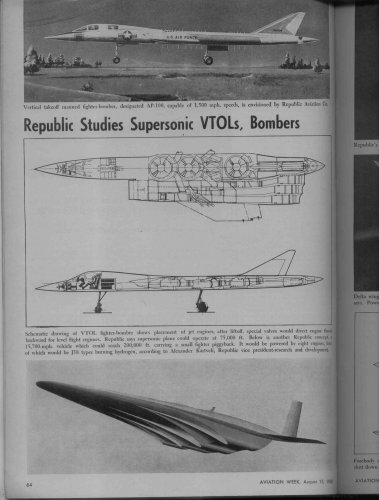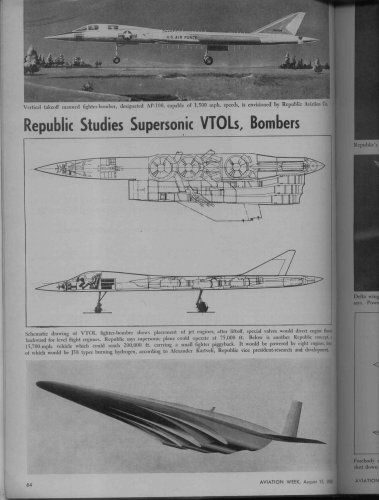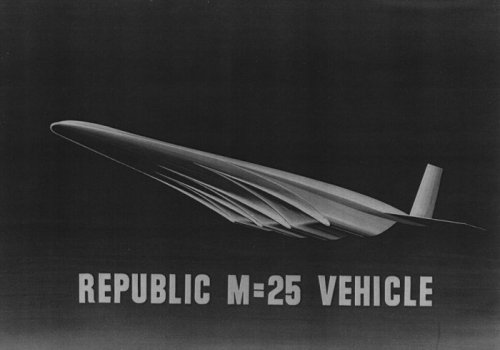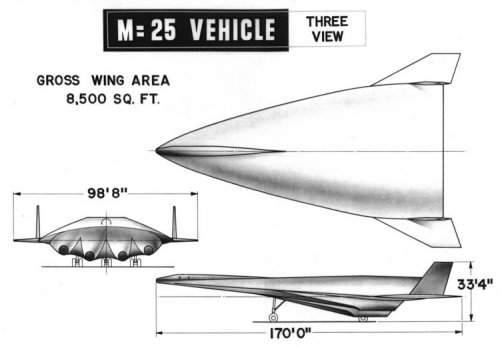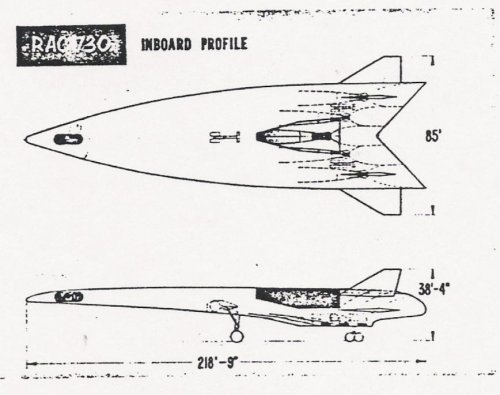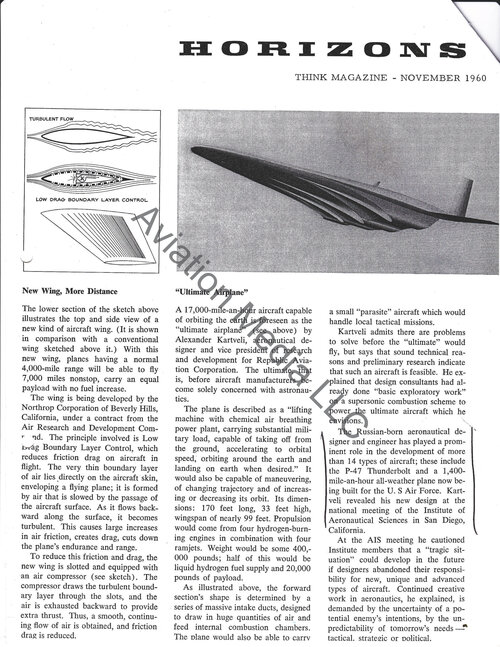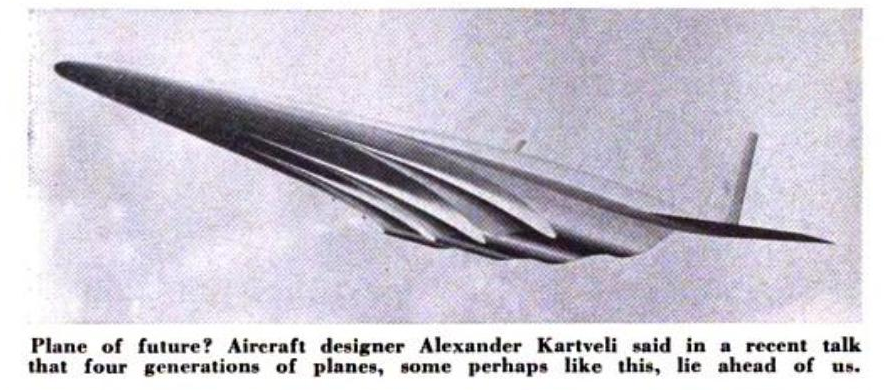You are using an out of date browser. It may not display this or other websites correctly.
You should upgrade or use an alternative browser.
You should upgrade or use an alternative browser.
Republic Mach 25 'Earth Orbiter' composite strike aircraft (1960)
- Thread starter Jemiba
- Start date
lark said:Years ago , Scott Lowther was also seaching for more info
about the Republic early spaceplane shown in Jemiba's illustration.
I wonder I he ever found it...
Sadly, no. I was contacted by one guy who claimed to have a paper about it, but I never heard back from him.
lark said:Years ago , Scott Lowther was also seaching for more info
about the Republic early spaceplane shown in Jemiba's illustration.
I wonder I he ever found it...
Actually: yes. Still nothing on the parasite fighter, but I've got good internal and external plan views and data on it (and the AP-100) now. I'll try to post something in the near future.
XP67_Moonbat
ACCESS: Top Secret
- Joined
- 16 January 2008
- Messages
- 2,259
- Reaction score
- 461
In the bottom of the article is artwork of an apparent hypersonic project from Republic. So what is known about this project? The intakes are vaguely reminiscent of the inward-turning variety you see popping up nowadays. Going off the D-21 experience, I'm not sure about the whole "piggyback fighter" idea. Anyone else know what became of this project?
Moonbat
Moonbat
Attachments
XP67_Moonbat said:In the bottom of the article is artwork of an apparent hypersonic project from Republic. So what is known about this project?
It was orbital, not just merely hypersonic.
I posted more/better pics and a bit of blather about this on my blog:
http://up-ship.com/blog/
Attachments
airrocket
Dreams To Reality
Never seen inlets quite like these somewhat reminiscent of more recent inward turning streamlined traced Buseman designs. Bounced the design off Paul Czysz he suggested Billig involvement and Brooklyn Polytechnic Institute Tony Ferri collaboration. The TBCC arrangement is interesting as well. The aft view helps to show nozzle design.
airrocket said:Never seen inlets quite like these somewhat reminiscent of more recent inward turning streamlined traced Buseman designs. Bounced the design off Paul Czysz he suggested Billig involvement and Brooklyn Polytechnic Institute Tony Ferri collaboration. The TBCC arrangement is interesting as well. The aft view helps to show nozzle design.
Actually, Ferri was referenced in Kartvelis writeup. The design is *very* similar to one shown in an article (that I have *somewhere* about a design put forward by Ferri of Marquardt.
shockonlip
ACCESS: Top Secret
- Joined
- 29 January 2008
- Messages
- 605
- Reaction score
- 50
This Republic era, represents one that I am fascinated with.
This design of Republics, although it was not the final one, represents the first
time that a major airframe company bucked the trend of that time of designing
rockets for space access, and instead proposing to develop an airbreathing and
lifting approach instead. Republic knew that it was not feasible in the immediate
future, but proposed it to stimulate development in this new line of thinking.
There were some influential aerodynamicists/designers in the late 1950's and
early 1960's who didn't really relish space access with rockets. Sasha Kartveli
as one of his chief designers, Gus Pappas called him, really preferred development
of atmospheric and military vehicles. Gus Pappas tells the story of this time at
Republic in his book: "To The Rainbow And Beyond". c1992; Vantage Press, NY.
Another was John Stack of NASA. John Becker's wonderful chapter in the
Hypersonic Revolution Volume I, mentions that Stack really didn't want to explore
space with rockets, even though he was an influential and leading high speed
flight expert at NASA in that era, and could have been an important leader in the
subsequent space program, Stack decided to leave NASA and go to Republic where
this airbreathing and lifting approach was being worked on instead.
This proposal of Republic's must have lit up the aerospace world! The paper
that Scott got these pictures from is entitled: "Spectrum Of Supersonic Aircraft".
It was presented at the IAS (Institute Of Aeronautical Sciences" - a forerunner
of AIAA)) National Meeting in San Diego from Aug 1-3, 1960. Look at the date on
that AW&ST picture at the bottom Aug. 15, 1960. The AW&ST piece was reporting
about this incredible paper that Kartveli gave at the IAS national meeting just 1-2
weeks previous. And just 4 months previous to the IAS national meeting, the Republic
guys were in Milan Italy, from April 4-8, 1960, presenting at the Fourth AGARD
Colloquium entitled "High Mach Number Air-Breathing Engines". Tony Ferri presented
a paper entitled: "Possible Directions Of Future Research In Air-Breathing Engines".
You'll notice that after that IAS conference presentation by Kartveli, that the aerospace
plane program took off in the US during the 1960s.
So this Republic design is a significant design. I like to think of it as the beginning, from
an airframe company standpoint, of the pure lifting/airbreathing approach for access to
space.
As far as AirRocket's question, there is another paper that Ferri gave later entitled:
"Theoretical And Experimental Investigation Of Supersonic Combustion". He also included
the same image as in AW&ST in this paper below an inlet schematic. The approach
IS very much like today's inward turning flowfield approach. The idea is a fixed geometry
isentropic surface inlet with good performance across a range of flight speeds.
And yes, Gus Pappas got Tony Ferri involved as their 'expert'. Gus talks about this in the
book I mentioned above in the chapter entitled: "17. The Ultimate Airplane" and then
chapter 18: "Pursuing The Concept Of Supersonic Combustion - Scramjet".
And Theodore von Karman was involved as well. Interesting story!
I'd check it out.
This design of Republics, although it was not the final one, represents the first
time that a major airframe company bucked the trend of that time of designing
rockets for space access, and instead proposing to develop an airbreathing and
lifting approach instead. Republic knew that it was not feasible in the immediate
future, but proposed it to stimulate development in this new line of thinking.
There were some influential aerodynamicists/designers in the late 1950's and
early 1960's who didn't really relish space access with rockets. Sasha Kartveli
as one of his chief designers, Gus Pappas called him, really preferred development
of atmospheric and military vehicles. Gus Pappas tells the story of this time at
Republic in his book: "To The Rainbow And Beyond". c1992; Vantage Press, NY.
Another was John Stack of NASA. John Becker's wonderful chapter in the
Hypersonic Revolution Volume I, mentions that Stack really didn't want to explore
space with rockets, even though he was an influential and leading high speed
flight expert at NASA in that era, and could have been an important leader in the
subsequent space program, Stack decided to leave NASA and go to Republic where
this airbreathing and lifting approach was being worked on instead.
This proposal of Republic's must have lit up the aerospace world! The paper
that Scott got these pictures from is entitled: "Spectrum Of Supersonic Aircraft".
It was presented at the IAS (Institute Of Aeronautical Sciences" - a forerunner
of AIAA)) National Meeting in San Diego from Aug 1-3, 1960. Look at the date on
that AW&ST picture at the bottom Aug. 15, 1960. The AW&ST piece was reporting
about this incredible paper that Kartveli gave at the IAS national meeting just 1-2
weeks previous. And just 4 months previous to the IAS national meeting, the Republic
guys were in Milan Italy, from April 4-8, 1960, presenting at the Fourth AGARD
Colloquium entitled "High Mach Number Air-Breathing Engines". Tony Ferri presented
a paper entitled: "Possible Directions Of Future Research In Air-Breathing Engines".
You'll notice that after that IAS conference presentation by Kartveli, that the aerospace
plane program took off in the US during the 1960s.
So this Republic design is a significant design. I like to think of it as the beginning, from
an airframe company standpoint, of the pure lifting/airbreathing approach for access to
space.
As far as AirRocket's question, there is another paper that Ferri gave later entitled:
"Theoretical And Experimental Investigation Of Supersonic Combustion". He also included
the same image as in AW&ST in this paper below an inlet schematic. The approach
IS very much like today's inward turning flowfield approach. The idea is a fixed geometry
isentropic surface inlet with good performance across a range of flight speeds.
And yes, Gus Pappas got Tony Ferri involved as their 'expert'. Gus talks about this in the
book I mentioned above in the chapter entitled: "17. The Ultimate Airplane" and then
chapter 18: "Pursuing The Concept Of Supersonic Combustion - Scramjet".
And Theodore von Karman was involved as well. Interesting story!
I'd check it out.
shockonlip
ACCESS: Top Secret
- Joined
- 29 January 2008
- Messages
- 605
- Reaction score
- 50
Here is a never before published (as far as I know) drawing of another of the
Republic scramjet designs. This is a later evolution of the previous discussed
ones in this topic. This one was published in a August 1961 paper from Republic
Aviation Corporation (RAC) entitled "Design Concepts and Technical Feasibility
Studies of an AEROSPACE PLANE" by A. Kartveli and C. Pappas.
The vehicle is known as RAC 730.
The quality of the images in my photocopy are unfortunatly very poor.
There are other design evolutions shown but many do not have enough left
to really show much.
Those of us who are good at archival search, should make efforts to find
a higher quality copy.
The paper was declassified in 1986.
Maybe the following helps as well:
RAC Publication No. 37 (don't think there is a 3rd digit, but not sure).
(ARD-730-907)
August 1961
Republic scramjet designs. This is a later evolution of the previous discussed
ones in this topic. This one was published in a August 1961 paper from Republic
Aviation Corporation (RAC) entitled "Design Concepts and Technical Feasibility
Studies of an AEROSPACE PLANE" by A. Kartveli and C. Pappas.
The vehicle is known as RAC 730.
The quality of the images in my photocopy are unfortunatly very poor.
There are other design evolutions shown but many do not have enough left
to really show much.
Those of us who are good at archival search, should make efforts to find
a higher quality copy.
The paper was declassified in 1986.
Maybe the following helps as well:
RAC Publication No. 37 (don't think there is a 3rd digit, but not sure).
(ARD-730-907)
August 1961
Attachments
- Joined
- 14 June 2006
- Messages
- 2,297
- Reaction score
- 485
Just an aside (but not much aside): when in 1962-3 Boeing did study for NASA-Marshall regarding ways of improving first stage booster performances with mixed propulsion engine (air-berathing rockets, like in LACE and RENE), the sole non-government and non-industry adressee of the report was Antonio Ferri at the Brookling Polytechnic Institute.
- Joined
- 1 April 2006
- Messages
- 11,048
- Reaction score
- 8,475
Historical Media Coverage & Awards — KARTVELI: Innovator in Aviation
Attachments
RetiredAFGuy
20 years of Phantom Phun
- Joined
- 10 January 2019
- Messages
- 28
- Reaction score
- 51
The bottom drawing, page 1 of a high Mach, high altitude mothership sure looks rather familiar in light of the Aurora/Brilliant Buzzard/Orient Express artwork and it comes from back in 1960. And powered by four J-58s plus four Scramjets, flying at 15,700mph at 200,000ft.Historical Media Coverage & Awards — KARTVELI: Innovator in Aviation
www.alexanderkartveli.com
How far back does the US hypersonic family tree go?
Similar threads
-
Republic Mach 7 delta wing bomber (1960)
- Started by flateric
- Replies: 4
-
-
-
-
SNCAN (Nord) "Griffon" developments and other high-speed projects
- Started by Antonio
- Replies: 80

